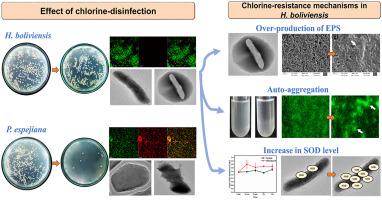当前位置:
X-MOL 学术
›
Int. Biodeterior. Biodegrad.
›
论文详情
Our official English website, www.x-mol.net, welcomes your feedback! (Note: you will need to create a separate account there.)
Systematic assessment of chlorine tolerance mechanism in a potent biofilm-forming marine bacterium Halomonas boliviensis
International Biodeterioration & Biodegradation ( IF 4.8 ) Pub Date : 2020-07-01 , DOI: 10.1016/j.ibiod.2020.104967 Meora Rajeev , T.J. Sushmitha , Krishnan Ganesh Prasath , Subba Rao Toleti , Shunmugiah Karutha Pandian
International Biodeterioration & Biodegradation ( IF 4.8 ) Pub Date : 2020-07-01 , DOI: 10.1016/j.ibiod.2020.104967 Meora Rajeev , T.J. Sushmitha , Krishnan Ganesh Prasath , Subba Rao Toleti , Shunmugiah Karutha Pandian

|
Abstract Bacterial colonization on submerged surfaces is a fundamental phenomenon associated with biofouling in the marine environment. To control such bio-growth, chlorination is the most commonly practiced strategy in maritime activities. Although chlorination is found to have wide-spectrum biocidal efficacy, it is unsuccessful against some microorganisms. Chlorine-resistant marine bacteria have attracted much attention as their existence enhances microfouling progression and could be a threat to industries that use seawater for cooling purposes. In this study, a chlorine-resistant bacterium that was isolated from the early-stage marine biofilm was in vitro investigated for biofilm-forming potential and chlorine tolerance. The bacterial isolate was identified phylogenetically as Halomonas boliviensis and its chlorine tolerance response was compared with a chlorine-sensitive bacterium (Pseudoalteromonas espejiana), which is taken as reference bacterium. Experiments on chlorine exposure revealed that H. boliviensis could mount an unusual response against chlorine and therefore even at long-term chlorine exposure (for 4–8 h) at 8 mg l−1 of residual chlorine concentration, elicited mere ≤ 1-fold reduction in the viable count. Chlorine-resistant mechanisms of H. boliviensis was ascertained by analyzing cellular morphology, cell membrane destruction, extracellular polymeric substances (EPS), aggregation ability and superoxide dismutase (SOD) pattern. In contrast to P. espejiana, over-production in biosynthesis of capsular EPS, induction in aggregation ability and increase in SOD level were observed and these could contribute to chlorine tolerance stratagem in H. boliviensis. Microscopic analyes revealed that both isolates form strong biofilms on various artificial surfaces. Scientific insight into such contrasting studies on marine bacteria is rather infrequent as well as important from environment perspective and would help in designing efficient antifouling strategy.
中文翻译:

一种有效的生物膜形成海洋细菌 Halomonas boliviensis 耐氯机制的系统评估
摘要 水下表面的细菌定植是与海洋环境中生物污垢相关的一种基本现象。为了控制这种生物生长,氯化是海上活动中最常用的策略。尽管发现氯化具有广谱的杀生物功效,但它对某些微生物不成功。耐氯海洋细菌引起了很多关注,因为它们的存在会加剧微污垢的发展,并且可能对使用海水冷却目的的行业构成威胁。在这项研究中,对从早期海洋生物膜中分离出的一种耐氯细菌进行了体外生物膜形成潜力和氯耐受性研究。该细菌分离物在系统发育上被鉴定为 Halomonas boliviensis,并将其耐氯反应与作为参考细菌的氯敏感细菌(Pseudoalteromonas espejiana)进行比较。氯暴露实验表明,玻利维亚人会对氯产生异常反应,因此即使在 8 mg l−1 的残留氯浓度下长期暴露氯(4-8 小时),也仅引起 ≤ 1 倍的减少在可行计数中。通过分析细胞形态、细胞膜破坏、细胞外聚合物 (EPS)、聚集能力和超氧化物歧化酶 (SOD) 模式,确定了玻利维亚人的耐氯机制。与 P. espejiana 相比,荚膜 EPS 的生物合成过度生产,观察到聚集能力的诱导和SOD水平的增加,这些可能有助于玻利维亚人的耐氯策略。显微分析表明,两种分离物都在各种人造表面上形成强大的生物膜。对海洋细菌的这种对比研究的科学见解相当少见,但从环境角度来看也很重要,将有助于设计有效的防污策略。
更新日期:2020-07-01
中文翻译:

一种有效的生物膜形成海洋细菌 Halomonas boliviensis 耐氯机制的系统评估
摘要 水下表面的细菌定植是与海洋环境中生物污垢相关的一种基本现象。为了控制这种生物生长,氯化是海上活动中最常用的策略。尽管发现氯化具有广谱的杀生物功效,但它对某些微生物不成功。耐氯海洋细菌引起了很多关注,因为它们的存在会加剧微污垢的发展,并且可能对使用海水冷却目的的行业构成威胁。在这项研究中,对从早期海洋生物膜中分离出的一种耐氯细菌进行了体外生物膜形成潜力和氯耐受性研究。该细菌分离物在系统发育上被鉴定为 Halomonas boliviensis,并将其耐氯反应与作为参考细菌的氯敏感细菌(Pseudoalteromonas espejiana)进行比较。氯暴露实验表明,玻利维亚人会对氯产生异常反应,因此即使在 8 mg l−1 的残留氯浓度下长期暴露氯(4-8 小时),也仅引起 ≤ 1 倍的减少在可行计数中。通过分析细胞形态、细胞膜破坏、细胞外聚合物 (EPS)、聚集能力和超氧化物歧化酶 (SOD) 模式,确定了玻利维亚人的耐氯机制。与 P. espejiana 相比,荚膜 EPS 的生物合成过度生产,观察到聚集能力的诱导和SOD水平的增加,这些可能有助于玻利维亚人的耐氯策略。显微分析表明,两种分离物都在各种人造表面上形成强大的生物膜。对海洋细菌的这种对比研究的科学见解相当少见,但从环境角度来看也很重要,将有助于设计有效的防污策略。


























 京公网安备 11010802027423号
京公网安备 11010802027423号